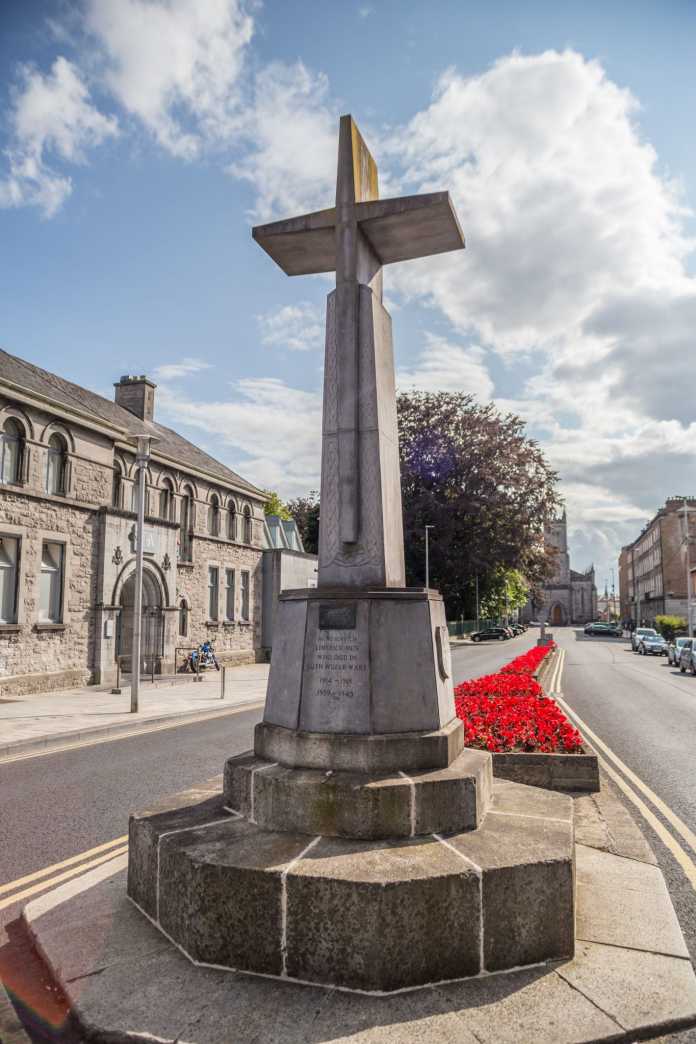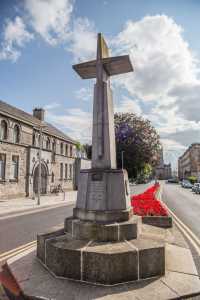

It has been bombed, boycotted and condemned as a symbol of British imperialism, yet the Limerick War Memorial in Pery Square is a potent reminder that the legacy of loss from the First World War transcends religious, political and social divisions. Dr Tadhg Moloney tells the story of how the memorial survived revisionism, ignorance and prejudice.
Eleven years after the end of the First World War, in which at least 3,000 officers and men from Limerick City and County died, a memorial in their honour and a place where the ex-servicemen and people of Limerick could come to pay homage was unveiled.
The conditions created by the War of Independence and Civil War meant it was only in 1924 that Roman Catholic ex-servicemen could hold a service of remembrance at St. Joseph’s Church. They continued to use this church until 1927 when the ceremony was transferred to St. John’s Cathedral.
By the time Remembrance Day came in 1922, a memorial had been unveiled in St. Mary’s Cathedral to the ‘Men of Thomond who fell in the war 1914-1918’. However, because this was a Protestant church, the attendance of Roman Catholic ex-servicemen was precluded. Six years later another memorial was unveiled, this time in the Presbyterian Church, Lower Mallow Street.
Personal memorials had been erected by families to their sons who died in the war, most notably in St Mary’s Cathedral. One of those is in memory of Captain Gordon Thompson Shaw killed in action on August 28, 1918, serving with the Royal Munster Fusiliers. He was the son of Alexander William Shaw, a leading bacon merchant in Limerick City.
The only memorial to a Limerick Roman Catholic soldier killed in the First World War is to be found in St. Munchin’s Roman Catholic Church. This memorial is in the form of a baptistery and was donated by Sir Vincent and Lady Nash to the memory of their son, Lieutenant James Haran Nash, who was killed serving with the Irish Guards on March 27, 1918.
Limerick still lacked a suitable monument where people irrespective of religious persuasion could commemorate their war dead.
However, on June 6, 1928 a deputation consisting of two members of the Limerick Branch of the Legion of ex-Servicemen, Captains David Tidmarsh and Eric R. Shaw, who was also a Borough Councillor, appeared before the Corporation Improvement Committee to support their application for the erection of a suitable memorial. The following day a letter was read to a full meeting of the Corporation from the Chairman of the Limerick Branch of the British Legion, which included a scale drawing of Pery Square and the location of where they would like the memorial to be erected covering an area of four square yards.
Permission was granted to erect the memorial in the Square by twenty-two votes to four, with Councillor C Gilligan abstaining, giving his reason for doing so on the basis that he was ‘opposed to the memorial on national grounds’. Those who voted against the proposal wanted the memorial situated in the People’s Park. There may also have been an underlying motive in having it located in the People’s Park and that was ‘out of sight, out of mind’. Councillor P O’Callaghan threatened to have it pulled down when it was erected.
Another indication that a public war memorial was going to be erected in Limerick was made at an Armistice dinner in the British Legion Hall, Lower Hartstonge Street on November 14, 1928 when Irish Legion Chairman A.P Connolly declared that ‘they were at last to have their war memorial in Limerick, a fact that reflected honour on the generous people of that city and county. Such a memorial would keep the grand ideal for which the men had fallen before them, and be an inspiration to them in the future’.
A list of subscribers published on November 9, 1929 showed that £357.10s.0d. had been contributed towards the required amount of £550. The willingness of people to subscribe is shown by a further list, published a month later, showing that the amount contributed had risen to £469.1s.0d, leaving an outstanding debt of £80.19s.0d.
Many of the 157 subscribers had relatives killed in the war or had served during the conflict. The individual amounts were not disclosed, signifying that the subscribers paid whether small or large were of equal importance.
The site for the memorial, a 20-foot version of the Cross of Sacrifice on an octagonal base with a bronze sword on its shaft, was donated by the City Council in the middle of the square directly opposite the Carnegie Library. Designed by Sir Reginald Bloomfield and constructed by Messrs CW Harrison and Sons, it was built of finely chiselled white Irish granite, of which one of the parts is mica, a material that sparkles in the sun or artificial light and bore the following inscription:
To the glory of God, and to the memory of 3,000 officers, NCOs and men of Limerick City and County who fell in the Great War, 1914-18. They died in every quarter of the earth and on its seas, and their names have with reverence and love been inscribed on our rolls of honour. Most of them lie buried in the lands of our Allies, who have set aside their resting place in honour for ever.
On November 10, 1929, both Catholic and Protestant ex-servicemen held separate services after which they marched to the memorial. The Protestant service was held in St. Mary’s Cathedral where ‘the sacred edifice had been filled to overflowing by a congregation representing all Protestant denominations in the city and county’ many of whom were ex-Servicemen, wearing their medals and decorations. A wreath on behalf of the Limerick Branch of the British Legion was laid at the Thomond War Memorial by Major-General Sir George Franks. The memorial Mass was held in St John’s Cathedral after which least six hundred ex-Servicemen, preceded by the Sarsfield Fife and Drum Band marched from John’s Square to Pery Square where a large crowd had gathered, including many women wearing their deceased husband’s, father’s or brother’s medals and decorations.
President of the British Legion in the Irish Free State Major-General Sir William Hickie, who had commanded the 16th Irish Division in France during the First World War and was therefore well known to and respected by the general body of the Ex-Servicemen present, unveiled the Cross which had been covered with a purple drape, symbolising the sacrifice of the men that the memorial commemorated.
In his address, he stressed that the sacrifice of the men to whom the memorial was erected was made for the highest motives and he made particular mention of the defence of Belgium. He also insisted that the basic motivation of the Allies in going to war had been honourable and made a plea for tolerance and understanding of differing points of view which he noted were absent in contemporary Ireland but which the occasion showed existed, as they always had, in Limerick:
“It is most fitting that this ancient city should have within its boundaries a monument which will not only stand to the glorious memory of those of her gallant sons who gave their lives in the cause of freedom and justice in the Great War, but will also serve to remind everyone of the great number of men from the County of Limerick, and from this its capital city, who took a distinguished part in the campaign of the Great War, and of the exemplary and gallant manner in which they carried out their self imposed duties. What we want most in Ireland to-day is that brotherly spirit which will recognise that we are all Irishmen of one great family, who are striving according to our lights, to do our best for the country which we love. Opinions and methods may differ, but nothing is to be gained by unkind criticism, by harsh words, or by wilful misunderstanding. Limerick has always set an example of that broad-mindedness and of that kindly spirit which are also, so noticeably absent at times from our public life. The cross now takes its place with the three crosses of Irish granite which stand respectively at Wytschaete in Flanders, at Guillemont and on the Somme in France and on the Serbian heights above Lake Doiran, as lasting memorials to those fifty thousand of our comrades who went out and who did not come back.”
While no wreath was laid on behalf of the Catholic Church quite a number of clergy were present at the ceremony, some of whom were ex-Chaplains to the army during the war. There was no official representation by the City Council at the ceremony. Although they had received an invitation, the Mayor decided that the vote to officially attend was unsuccessful ‘when four members voted for not accepting the invitation and seven for accepting.
The only member of the Council who attend in a private capacity was Alderman P O’Flynn.
The attendance of the Mayor and Council in an official capacity at the unveiling ceremony was obviously a step too far.
It wasn’t until 1991, sixty-two years after the unveiling before Mayor Jim Kemmy attended and laid a wreath on behalf of the city council, thereby establishing a precedent that has continued to this day.
The ex-Servicemen now had a place to go to pay homage to their fallen comrades. Every year, with the exception of the years 1939-45, they assembled at the Cross on the nearest Sunday to the eleventh day of November, the date of the end of the war.
After the Second World War, a plaque was added to the war memorial to commemorate the Limerick men from Limerick who were killed in action serving with the Allies during that conflict.
Not everyone agreed with what the war memorial symbolised or the sentiments expressed on it and during the early hours of August 7, 1957 it was destroyed by an explosion. The Secretary of the Limerick Branch of the British Legion, Mr John Ring, declared that the war memorial ‘had no political significance and was merely there to commemorate our Limerick men who were killed in the First World War and also in the Second World War. That was the only purpose of it’.
The day after the explosion, the Limerick Chronicle published a disclaimer from ‘the local Secretary of a Proscribed organisation stating that the organisation was not responsible for the blowing up of the War Memorial and that no member of the Republican Movement was involved in the incident’.
No group or individuals ever took responsibility for this action and nobody was apprehended for it, though its occurrence during the IRA border campaign pointed to the most likely source. The death of Limerick man Seán Sabhat the previous January may also have been a relevant factor.
However, like the phoenix rising from the ashes, a new war memorial was built on the base of the old Cross of Sacrifice to symbolise a new era of inclusion and enlightenment.
Read similar articles in the Limerick Post Community section.





